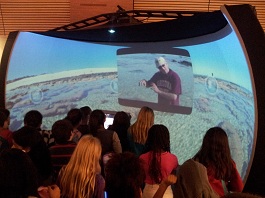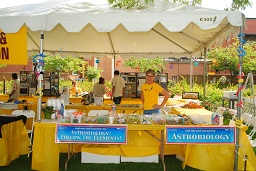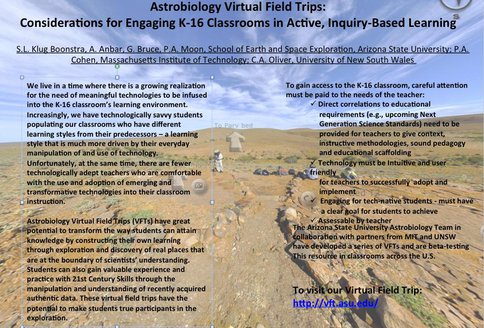2012 Annual Science Report
 Arizona State University
Reporting | SEP 2011 – AUG 2012
Arizona State University
Reporting | SEP 2011 – AUG 2012
EPO Activity: Follow the Elements EPO Formal/ Informal Education and Public Outreach
Project Progress
The ASU “Follow the Elements” Astrobiology Team made significant progress in furthering their key innovative education and public outreach (E/PO) programs and products this year. These Astrobiology programs and products not only emphasize and utilize on-line education environments, but tap into the growing market of tech-savvy students who are the ultimate end-user of these products. Integrating the engaging and rich astrobiology content into these environments is proving to be a dynamic match that will be need for this growing market and enabling more students to grasp the process of science.
Habitable Worlds
In Fall, 2011, PI Anbar offered the general science course for non-majors – Habitable Worlds (GLG 106) – for a second year, this time fully online. The course was offered again in Spring, 2012, by instructor Lev Horodyskyj. Habitable Worlds uses the Drake Equation as an organizing framework to cover topics ranging from astrophysics to sustainability. The course involves a number of innovative technologies. Importantly, it was built via collaboration between ASU and an Australian startup company (Smart Sparrow) that was catalyzed by Carol Oliver of the ACA. The course also includes virtual field trips developed in collaboration with the ACA and the NAI’s MIT team.
Habitable Worlds had a total of 300 undergraduate students enrolled during the last year, increasing the enrollment tenfold over the initial course offering last year. Using the technology developed and enabled by the start-up company, PI Anbar, Geoffrey Bruce and Dr. Lev Horodyskyj were able to further develop the course to be more impactful and user-friendly. They were able to monitor the progress of the students in real-time and make adjustments to the course as needed.
Virtual Field Trips
A major focus this year was on our continuing development of the Astrobiology Virtual Field Trips (VFTs). Our lead VFT designer – Geoffrey Bruce made substantial progress toward making the experience more user-friendly. These efforts included:
Development:
*Building the initial VFT architecture in HTML5;
*Created design and concept of thin VFT (based on educator focus group feedback);
*New Skin, shadowbox integration, and floating integrated windows;
*Direct integrated Gigapan content;
*360 degree object creation;
*Ability to select multiple “topic based content” within a VFT;
*Developed new VFT website and landing page; and
*Template container for external content development.
*Initial integration of Smart Sparrow’s adaptive eLearning platform to guide experiences.
Content Creation (all collaborative with the ACA and MIT team): *Nilpena thin VFT – oldest multicellular animals *Shark Bay thin VFT – living microorganisms
*Created second stage of Shark Bay full VFT
*Archaeocyathid Reef – first reef building animals VFT
*Ediacaran Layers in Time – Golden Spike VFT
*Pichi Richi Trail – Ancient Earth VFT
*Parachilna formation Gully Worm Burrows VFT
*Enorama Creek – ancient records of life VFT
Additional Partner VFT Development (These VFTs are funded from other sources – and many have tie-points to overall Astrobiology themes. These partners also show the replicability of the Astrobiology VFT model.)
*Upheaval dome VFT (funded by a NASA EPOESS award) *Panama rain forest VFT (funded by ASU)
*Teotihuacan VFT (funded by ASU)
*Mossel Bay VFT (funded by ASU)
*Hawaii VFT (funded by the NAI’s UH team)
*Iceland VFT (funded by the NAI’s UH team)
*Yellowstone VFT (funded by an NAI supplemental award)
To gather high school and higher education user feedback, G. Bruce held VFT teacher focus groups in the San Francisco Bay area and “Follow the Elements” team member – Dr. Phoebe Cohen incorporated Astrobiology VFTs into her MIT coursework. Feedback was also gathered from “Follow the Elements” collaborator C. Oliver in Australia. Based on this research and user feedback, a VFT introduction was incorporated into the VFT structure. Work is continuing on in reworking older VFTs into the newer structure using the lessons-learned from this year’s work.
ASU’s new Interdisciplinary Science and Technology Building (ISTB4) has a 4,300-square-foot “Gallery of Scientific Exploration,” outfitted with kiosk-style interactive exhibits and large-format, high-definition monitors that display video from Earth-observing satellites and robotic probes of other worlds. Astrobiology content is being integrated into this public area and a VFT has been installed on one of the interactive kiosks.
VFT Evaluation
An education evaluator for the VFTs was selected this year. Dr. Sanlyn Buxner of the Planetary Science Institute will begin work in Spring 2012 and will help to design an evaluation plan and collect the data related to Astrobiology VFTs.
Professional Development for Teachers
In mid-June 2012 the Triad Project, an educational collaborative of the American Geosciences Institute (AGI), the School of Earth and Space Exploration at ASU, and NASA Goddard Space Flight Center, offered its second annual Teacher Leadership Academy (TLA) in Earth and Space Sciences. The TLA was offered to in-service middle/high school Earth and Space Science teachers, Environmental or Integrated Science teachers, pre-service science teachers, ELL science teachers and informal educators who already are, or who have the potential to become, science professional development leaders in their home school districts.
The TLA and its ancillary activities were funded by NASA Goddard Space Flight Center through a K-12 Cooperative Agreement with AGI and ASU. NAI PI Anbar and Co-PI Semken are also Triad Project Co-PIs, and this enabled considerable cross-pollination between NAI science and Triad teacher professional development activities. Both Semken and Anbar were facilitators and presenters at this workshop.
The 40 hour content-rich, transdisciplinary TLA was presented at SESE and included the following topics: *Introducing Earth system science to students;
*Teaching Earth and space science with inquiry and place-based approaches;
*Investigations to help students understand the Nine Big Ideas in Earth Science from the Earth Science Literacy Principles;
*Current NASA research conducted at SESE and other institutions, and other hot topics in Earth and space sciences;
*Resources for learning and teaching Earth and space science;
*Using learning centers in classroom and workshop settings; and
*Planning, conducting and evaluating successful Earth and space science workshops.
The TLA was immediately followed by an optional 4-day geological field trip to the Colorado Plateau, featuring investigation of two impact craters (Upheaval Dome at Canyonlands National Park and Meteor Crater), and a survey of geological processes and features in Plateau localities such as Canyon de Chelly and Petrified Forest. The trip was led by Semken and the Upheaval Dome segment was led by SESE graduate student and NAI collaborator Cameron Mercer. The investigation at Upheaval Dome was in part carried out as reconnaissance for a subsequent NAI-led trip there to collect video and other data for a Virtual Field Trip.
Public Outreach Events
The “Follow the Elements” Team took part in some large ASU-leveraged events to help communicate the value and messages of Astrobiology research. These events are open to the public and centered around family activities.
*ASU Homecoming Event – Over 10,000 people attended the street-fair style event with the ASU NAI booth hosting hands-on activities, multimedia and Astrobiology storyboards telling the story of ASU’s NAI efforts.
*ASU Earth and Space Exploration Day Event – This event hosted 1200+ adults and children during a full day of interactive time to bring the excitement of NAI Astrobiology research to the public.

ASU ISTB4 Interactive Kiosk Displaying Astrobiology Virtual Field Trip

Over 10,000 people attended the street-fair style event with the ASU NAI booth hosting hands-on activities, multimedia and Astrobiology storyboards telling the story of ASU’s NAI efforts.
This poster was based on education research, input from focus groups and lessons-learned from our “Follow the Elements” team education efforts.
